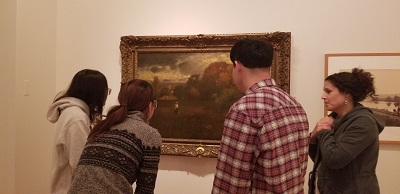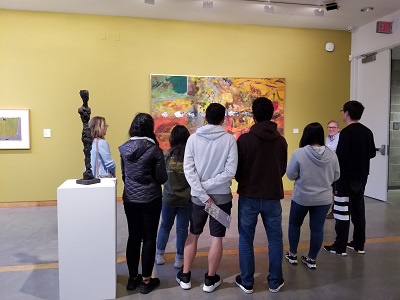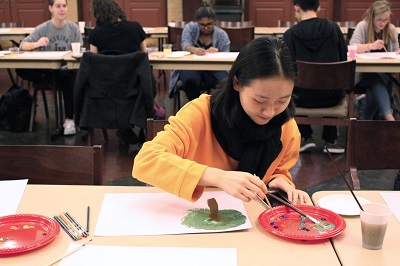|
Art to Build Community and Validate Identity
Art-inspired assignments can be utilized and adapted in a
myriad of ways in multilingual classes. When properly scaffolded, art
can be incorporated in practically any lesson or skillset (i.e.,
reading, writing, speaking, or listening). Incredibly versatile,
art-based assignments can also be adapted for language level and age
group, as students are able to critically discuss concepts and
identities because artistic interpretations fall outside the domain of
“right/wrong, true/false paradigms” (Duke, 2010, p. 272). As such, art
opens up a world of possibilities for multilingual students and provides
“a significant intersection between language, identity, and culture”
(Cloutier et al., 2016, p. 141). As a result, our students have retained
more, taken more risks, and engaged more.
As one student noted, “I think everyone cares about different
points, so of course, the points that can trigger me may not trigger the
others.” Our student’s point emphasizes that art as a pedagogical tool
provides a safe and desirable space for students to engage in meaningful
dialogue that validates their multicultural identity and voice,
creating a community within the class.
This community can be built within the physical classroom or be
more experiential, like going to an art gallery either physically or
virtually. We firmly believe that community building is the first step
towards successful implementation of art-inspired projects and an
integral part of developing successful curricula so that students feel
empowered to observe, interpret, debate, describe, and write about art
with confidence. As such, it is incumbent upon instructors to explain
that art is subjective; we may see the same image but will likely
interpret it differently. As seen in Figure 1, through modeling and
rehearsing visual literacy in the classroom, students will develop
confidence in their skills as visual interpreters, building autonomy
before embarking on a project.

Figure 1: Students Evaluating Art
To initiate this autonomy, you might set up stations around the
classroom with images and chart paper. Invite the students to
contribute ideas to the chart paper, allowing them to interact with each
other as they move from station to station around the classroom. If
students are new to art, encourage them to simply write what they see;
those who have some experience could share their judgement and/ or
interpretations.
Lesson Preparation and Adaptations
Preparation of lessons requires careful scaffolding and an
understanding of what art does for the learner’s
language development. Art develops “literacy as a social practice” as
well as “visual literacy” (Street, 1995), and helps to facilitate
transmediation which is the bridge between what students can see and
what meaning they can create in “another sign system” such as art
(Harste, 2014). Therefore, art is a vehicle for expression that fosters
development of new vocabulary and skills that are contextually
appropriate rather than mere memorization. In addition, art provides
inspiration for higher-order thinking such as analysis, description,
discussion, and even debate. These experiences allow students to become
personally invested; thus, enabling instructors “to link students’ words
with their world, on the one hand, and their identities, affective
investment, and language learning, on the other” (Cloutier et al., 2016,
p. 150). As another student aptly stated, “Using art to conduct class
is to choose an appropriate way to guide students to be willing to
communicate according to different students; situations and different
classroom atmospheres.” As seen in this quote, this understanding
promotes buy in among students and skeptics alike, something we must
acknowledge because art as a vehicle to teach is not always initially
understood, which is why the foundational steps (i.e., instructor
modeling) in lesson preparation is so crucial.
Laying the foundation ensures that all students are comfortable
with expressing opinions about art, starting in small groups. We like
to introduce sample art (e.g., photos, paintings) --either online or
print--for students to analyze and discuss in class. As a first step,
students might be invited to respond to open-ended questions like “What
do you see?” or “How does this make you feel?” as seen in Figure 2.
Thus, lower level students may simply supply terms like happy or sad, while higher
level students may produce terminologies such as apprehensive or melancholy.
This is an opportunity to build vocabulary, participate in discussion or
writing, all while reiterating the fact that there isn’t one right
answer because students may react differently to art. The next step
might be to ask students to write a sentence or two to share with a
partner. Most importantly, inform students that their interpretations
are valuable, and varying interpretations make the class more
interesting.

Figure 2: Discussion of Abstract Art
Beyond this, lessons can develop in a variety of ways depending
on the objectives and level(s) of the students. “When combined with
reading, writing, speaking and listening, art can open doors for high
levels of analysis and also challenge students to explore themselves and
their surroundings and thus find avenues for sophisticated
comprehension and communication” (Farokhi & Hashemi, 2012, p.
923). About writing and art, one of our university students said, “I
think we did use art in our classes. One way we did through this is self
expression [sic] in our diaries, I felt like that
gave me a chance to express myself of how I felt in the moment. It was a
pivotal step on reflecting about myself and my overall wellbeing as a
student, which would later translate in my class writings.” Table 1
below details a lesson that we have done with our first-year composition
students along with suggested adaptations for varying ability. Table 2
illustrates the versatility of art to teach English.
Table 1
Sample Lesson and Leveled Adaptations
|
Lesson/ genre |
Advanced |
Intermediate |
Emerging |
|
Write a Review |
Advanced students are familiar with this genre, both as consumers and as writers.
Students select a work of art, research its background and
write a review. Scaffold this activity by showing instructor-generated
examples. |
Intermediate students are likely to
be just as familiar with reviews because of the ubiquity and utility of
reviews, but may lack experience in writing them.
Scaffold by showing reviews of products that may appeal to your
students. Scribe words on the board then build on this activity by
introducing art. |
Emerging students may be familiar
with this genre, but we recommend hands-on scaffolding. Invite students
to look at reviews that include stars for rating.
Give a template, inviting students to discuss what they
like/dislike before rating. Scribe words to validate these ideas/
interpretations. |
Table 2
Examples of Projects and Adaptations
|
Project |
Description |
|
Sketching/ Painting |
Sketching/ Painting, as seen in
Figure 3, is a way to unlock ideas. Through visual analysis, students
may discover aspects of art that they may not initially
see. |
|
Presentation/ Opinion speech |
Presentations offer practice for oral
language development. This is an authentic way to teach
pragmalinguistic awareness and incorporate art. |
|
Analysis |
Analysis of artistic works enables
students to express themselves and conduct research. One option is to
select two works of art using a Venn diagram as support to compare and
contrast. |
|
Profile |
Profiles allow students to present
the subject (the art gallery, an event, a person, etc.) in an
entertaining way that conveys its significance, showing a unique angle.
This can be a multimodal assignment. |
|
Haiku or shape poems |
Haiku is a simple model leading to
strikingly complex poems. Students select a work of art to represent
their poem. Shape poems are inspired by abstract nouns or by nature.
(e.g., a leaf or a feather). Scaffold by providing words or
shapes. |
|
Short stories |
Short stories provide autonomy to
evaluate art and write a creative story. It’s a great assignment for all
ages and proficiency levels. |

Figure 3: Student Painting with Watercolors
Suggested Resources
As mentioned earlier, instructors can utilize what they have at
hand, using online resources to engage students and enhance language
learning and development. Now, it is easier than ever to bring an art
gallery to your classroom utilizing virtual tours or other online
resources.
How exciting is it that you can travel halfway across the world
to see extraordinary works of art right in the classroom? Here are some
we recommend:
We also suggest collaboration with your school’s art
department, supporting or building on an existing project. Other arts
such as music, theater, or dance also work. Our students have even
created monologues after incorporating interviews and performances from a
local theater company. Students have also combined music with a poetry
reading.
Conclusion
Using art to teach English is a wonderful way to inspire and
engage with students in the multilingual classroom. In our almost six
years of collaboration and experience utilizing art to teach English to
our multilingual students, we have used art in a variety of ways. The
possibilities are endless to create meaningful projects that build
confidence, community, and critical thinking.
References
Cloutier, G., Ibrahim, A., & Pratt, D. (2016).
Subversive identities at the art museum: An ESL university student’s
experience at the National Gallery of Canada. Canadian Review
of Art Education, 43(1), 139-152. doi:
10.26443/crae.v43i1.22.
Duke, L. (2010). The museum visit: It’s an experience, not a
lesson. Curator the Museum Journal, 53(3), 271-279. doi:
10.1111/j.2151-6952.2010.00028.x
Farokhi, M., & Hashemi, M. (2012). The impact/s of
using art in English language learning classes. Procedia -
Social and Behavioral Sciences, 31,
923-926. doi: 10.1016/j.sbspro.2011.12.170.
Harste, J. (2014). The art of learning to be critically
literate. Language Arts, 92(2), 90-102. Retrieved from
http://www.jstor.org/stable/24575621
Street, B. (2003). The limits of the local- ‘Autonomous’ or
‘disembedding’? International Journal of Learning, 10, 2825-2830. Retrieved from
http://igenlit.pbworks.com/f/street_LimitsOfTheLocal.pdf
Kayla Landers, MA TESOL, teaches undergraduate writing courses,
graduate courses, and noncredit intensive English classes at Lehigh
University. In addition to using art, her interests include language
assessment and technology use in the classroom.
Mary Newbegin, MEd TESOL, teaches at Lehigh University
including courses in graduate writing, speaking and listening, first
year composition, and in the Intensive English Program. Her interests
include multimodal composition, online learning, and innovative
approaches to first year composition. |

